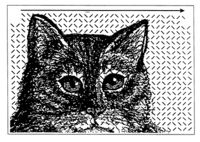DataGlyph
From Just Solve the File Format Problem
(Difference between revisions)
Dan Tobias (Talk | contribs) |
m |
||
| (One intermediate revision by one user not shown) | |||
| Line 5: | Line 5: | ||
|caption=Illustration from DataGlyph patent | |caption=Illustration from DataGlyph patent | ||
}} | }} | ||
| − | + | '''DataGlyph''' is a proprietary bar code technology created at Xerox PARC and covered by [http://www.freepatentsonline.com/6641053.html US Patent 6,641,053]. It encodes data by lines leaning in one of two directions, which correspond to zero or one bits in the data being encoded. The resulting pattern of lines can be concealed in an image so that it doesn't obviously look like a bar code of any sort (this sort of hidden data is known as [[steganography]]). | |
| − | '''DataGlyph''' is a proprietary bar code technology created at Xerox PARC and covered by [http://www.freepatentsonline.com/6641053.html US Patent 6,641,053]. It encodes data by lines leaning in one of two directions, which correspond to zero or one bits in the data being encoded. The resulting pattern of lines can be concealed in an image so that it doesn't obviously look like a bar code of any sort (this sort of hidden data is known as | + | |
== Links == | == Links == | ||
| Line 13: | Line 12: | ||
* [http://computer-related-digest.blogspot.com/2008/03/dataglyphs-xeroxs-new-technology-for.html Article on DataGlyphs] | * [http://computer-related-digest.blogspot.com/2008/03/dataglyphs-xeroxs-new-technology-for.html Article on DataGlyphs] | ||
* [http://citeseerx.ist.psu.edu/viewdoc/download?doi=10.1.1.64.4555&rep=rep1&type=pdf Paper on reading DataGlyphs] | * [http://citeseerx.ist.psu.edu/viewdoc/download?doi=10.1.1.64.4555&rep=rep1&type=pdf Paper on reading DataGlyphs] | ||
| + | |||
| + | [[Category:Xerox]] | ||
Latest revision as of 16:41, 15 June 2017
DataGlyph is a proprietary bar code technology created at Xerox PARC and covered by US Patent 6,641,053. It encodes data by lines leaning in one of two directions, which correspond to zero or one bits in the data being encoded. The resulting pattern of lines can be concealed in an image so that it doesn't obviously look like a bar code of any sort (this sort of hidden data is known as steganography).
